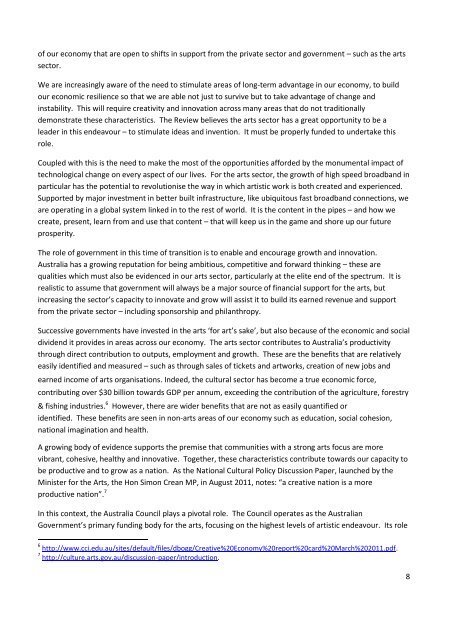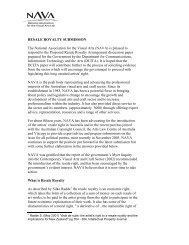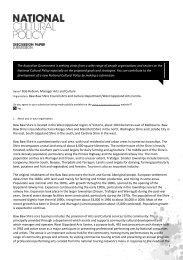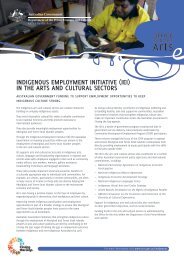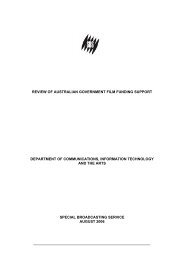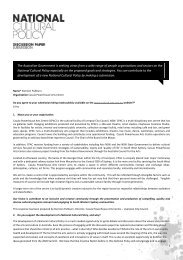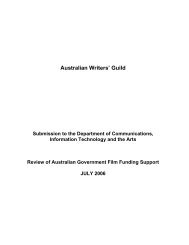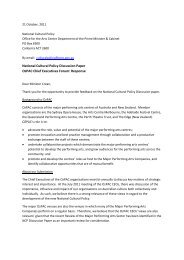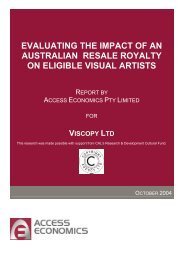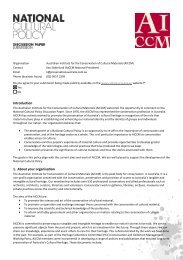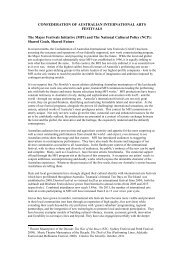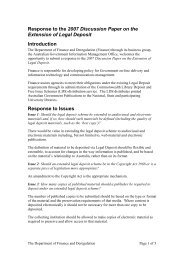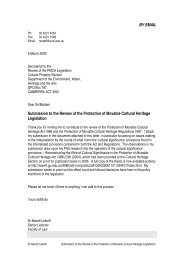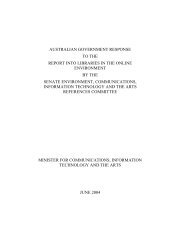of our economy that are open to shifts in support from the private sector and government – such as the artssector.We are increasingly aware of the need to stimulate areas of long-term advantage in our economy, to buildour economic resilience so that we are able not just to survive but to take advantage of change andinstability. This will require creativity and innovation across many areas that do not traditionallydemonstrate these characteristics. The Review believes the arts sector has a great opportunity to be aleader in this endeavour – to stimulate ideas and invention. It must be properly funded to undertake thisrole.Coupled with this is the need to make the most of the opportunities afforded by the monumental impact oftechnological change on every aspect of our lives. For the arts sector, the growth of high speed broadband inparticular has the potential to revolutionise the way in which artistic work is both created and experienced.Supported by major investment in better built infrastructure, like ubiquitous fast broadband connections, weare operating in a global system linked in to the rest of world. It is the content in the pipes – and how wecreate, present, learn from and use that content – that will keep us in the game and shore up our futureprosperity.The role of government in this time of transition is to enable and encourage growth and innovation.Australia has a growing reputation for being ambitious, competitive and forward thinking – these arequalities which must also be evidenced in our arts sector, particularly at the elite end of the spectrum. It isrealistic to assume that government will always be a major source of financial support for the arts, butincreasing the sector’s capacity to innovate and grow will assist it to build its earned revenue and supportfrom the private sector – including sponsorship and philanthropy.Successive governments have invested in the arts ‘for art’s sake’, but also because of the economic and socialdividend it provides in areas across our economy. The arts sector contributes to Australia’s productivitythrough direct contribution to outputs, employment and growth. These are the benefits that are relativelyeasily identified and measured – such as through sales of tickets and artworks, creation of new jobs andearned income of arts organisations. Indeed, the cultural sector has become a true economic force,contributing over $30 billion towards GDP per annum, exceeding the contribution of the agriculture, forestry& fishing industries. 6 However, there are wider benefits that are not as easily quantified oridentified. These benefits are seen in non-arts areas of our economy such as education, social cohesion,national imagination and health.A growing body of evidence supports the premise that communities with a strong arts focus are morevibrant, cohesive, healthy and innovative. Together, these characteristics contribute towards our capacity tobe productive and to grow as a nation. As the National Cultural Policy Discussion Paper, launched by theMinister for the Arts, the Hon Simon Crean MP, in August 2011, notes: “a creative nation is a moreproductive nation”. 7In this context, the Australia Council plays a pivotal role. The Council operates as the AustralianGovernment’s primary funding body for the arts, focusing on the highest levels of artistic endeavour. Its role6 http://www.cci.edu.au/sites/default/files/dbogg/<strong>Creative</strong>%20Economy%20report%20card%20March%202011.pdf.7 http://culture.arts.gov.au/discussion-paper/introduction.8
is to work as the expert agency quarantined from the tides of government and politics by its legislativemandate. Like the sector it is designed to fund, it needs to be able to innovate, to respond to change and totake advantage of opportunities wherever they may present themselves. In doing so, it will be able tosupport a sector that is also responsive and flexible.In <strong>2012</strong> the Australian Government has committed to developing a National Cultural Policy that aims to placethe arts front and centre in the national psyche. This important piece of work will influence the next decadeof Australian Government investment in, and support for the arts. The Review of the Australia Council formsa central part of the process to develop the Policy. It could not come at a better time for the Australian artssector.*****The Review received a broad mandate from the Australian Government through its terms of reference.Essentially, we were tasked with looking at the very principles underpinning the establishment of the Counciland to consider whether its original purpose continues to be relevant today. As a second arm of thisconsideration, we were also asked to look at how the Council could better serve its purpose in futurethrough an improved governance model. The full terms of reference for the Review are included on page 11.A number of key themes emerged through the consultation undertaken for this Review. In particular, therewas a strong recognition among stakeholders of the important role the Council has played in developing theAustralian arts sector as it is today. There was a high degree of support for the Council and anacknowledgement of the skills and expertise of its staff and peer reviewers. At the centre of this is faith inthe two principles on which the Council was established – that is, operation at arm’s length fromgovernment, and decision-making on funding based on the assessment of artistic merit by a panel of peers.Furthermore, there was almost universal support for the view that the Council should primarily support workof artistic ‘excellence’, in all its guises. Finally, stakeholders highlighted the ever-present need for the Councilto be flexible and strategic – more nimble – in relation to how it allocates its funding, to enable it to adaptand change along with the sector.Ultimately, the Review makes eighteen recommendations across six areas that outline a broad mandate forchange. These recommendations, and the conclusions that support them, are listed in full below beginningat page 13. In relation to the Council’s purpose, the Review recommends it be updated to ensure that theCouncil focuses on funding and promoting artistic excellence in all its forms, leaving the primary work ofpolicy development and programs supporting broad access to the arts to the department of state – theOffice for the Arts. In making this recommendation we recognise the interlinked nature of access andexcellence in the artistic life cycle – these concepts are not mutually exclusive. It is also clear to this Reviewthat the standard of excellence is difficult to define and highly subjective, but as the expert funding body forthe arts, the Council is well-placed to make this assessment, using peers drawn from the sector as its decisionmakers.The Review recommends the Council focus on four areas of activity in pursuing its purpose: providing fundingto promote and sustain excellence in the arts sector, promoting a sector that is distinctly Australian, ensuringthere are audiences and markets for the work it funds and promotes, and working to maximise the social andeconomic contribution made by the arts sector to Australia. In doing this, the Council must also increase itscollaborations and linkages across all levels of government and within the sector. To meet identified needs9
- Page 2 and 3: Cover image: Travelling Colony by B
- Page 4 and 5: In undertaking the Review, we have
- Page 6 and 7: IntroductionIn 1973, the National G
- Page 10 and 11: and enable the Council to fulfil it
- Page 12 and 13: MethodologyOn 19 December 2011 the
- Page 14 and 15: Recommendations: PurposeRecommendat
- Page 16 and 17: ooThe Council’s role within this
- Page 18 and 19: Recommended Functional Map for the
- Page 20 and 21: major and key organisations with sm
- Page 22 and 23: Comparison of government arts expen
- Page 24 and 25: 4. Key conclusions: The Council’s
- Page 26 and 27: Recommendation 10The Review recomme
- Page 28 and 29: Core elements of a revised structur
- Page 30 and 31: oThe Review believes the balance be
- Page 32 and 33: Recommended Grants Application Proc
- Page 34 and 35: Figure 33 - Overall Administrative
- Page 36 and 37: 6. Key conclusions: The Australia C
- Page 38 and 39: Appendix 1: Biography of Mr Angus J
- Page 40 and 41: Appendix :Australia Council ReviewS
- Page 42 and 43: 5.1.1 Diversify Funding ...........
- Page 44 and 45: The analysis of survey data should
- Page 46 and 47: 2. Introduction2.1 BackgroundAs par
- Page 48 and 49: differences at the 95% confidence l
- Page 50 and 51: 3. Relationship and experience with
- Page 52 and 53: 3.2 Perceptions of the grant applic
- Page 54 and 55: 3.3 Importance of Australia Council
- Page 56 and 57: 4. Perceptions of the Australia Cou
- Page 58 and 59:
„To support, encourage and promot
- Page 60 and 61:
„To develop, advocate, resource,
- Page 62 and 63:
4.2 Original purpose of the Austral
- Page 64 and 65:
4.2.3 Agreement with statements abo
- Page 66 and 67:
Figure 12: Agreement with statement
- Page 68 and 69:
4.3.1 Funding the arts/ artistsThe
- Page 70 and 71:
Responding to a changing industry,
- Page 72 and 73:
5. Practical suggestions for change
- Page 74 and 75:
„98% of Australia Council funding
- Page 76 and 77:
5.1.3 Improve communication and con
- Page 78 and 79:
within the music scene to 'support
- Page 80 and 81:
„I think the review should look a
- Page 82 and 83:
excellence is defined primarily by
- Page 84 and 85:
model, or could offer matching ince
- Page 86 and 87:
5.3 Definitions of excellenceThere
- Page 88 and 89:
• Decided by audience, peers, com
- Page 90 and 91:
5.3.5 Conceptual definitionsThere w
- Page 92 and 93:
6. Profile of respondentsDemographi
- Page 94 and 95:
Figure 21: Location%SydneyNew South
- Page 96 and 97:
Figure 24: Role in the arts%An arti
- Page 98 and 99:
6.7 Art-formMusic was the art-form
- Page 100 and 101:
A: BackgroundTo start with, we woul
- Page 102 and 103:
Literature 4Music 5Theatre 6Visual
- Page 104 and 105:
ASK ALLC4. Listed below are several
- Page 106:
55 - 64 665 - 74 775+ 8Prefer not t


